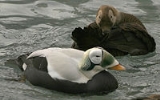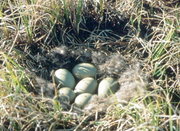
Spectacled Eider
Encyclopedia
The Spectacled Eider is a large sea duck
that breeds on the coasts of Alaska
and northeastern Siberia
.
 The lined nest is built on tundra close to the sea, and 5–9 eggs are laid. This species dives for crustacean
The lined nest is built on tundra close to the sea, and 5–9 eggs are laid. This species dives for crustacean
s and molluscs. The winter range is poorly known, but satellite tracking has led to observations of large flocks of the birds about 100 km southwest of St. Lawrence Island in the Bering Sea during March-April. This area has large populations of bivalves in the underlying sediments at depths of about 60 m that the ducks dive to feed on.
The Spectacled Eider is slightly smaller than the Common Eider
at 52–57 cm in length. The male is unmistakable with its black body, white back, and yellow-green head with the large circular white eye patches which give the species its name. The drake's call is a weak crooning, and the female's a harsh croak.
The female is a rich brown bird
, but can still be readily distinguished from all duck
s except other eider
species on size and structure. The paler goggles are visible with a reasonable view and clinch identification. Immature birds and eclipse adult drakes are similar to the female.
The Spectacled Eider is listed in the US as a Federally Threatened species and is unhuntable.
The binomial commemorates the German scientist Johann Fischer von Waldheim
.
Merginae
The seaducks, Merginae, form a subfamily of the duck, goose and swan family of birds, Anatidae.As the name implies, most but not all, are essentially marine outside the breeding season. Many species have developed specialized salt glands to allow them to tolerate salt water, but these have not yet...
that breeds on the coasts of Alaska
Alaska
Alaska is the largest state in the United States by area. It is situated in the northwest extremity of the North American continent, with Canada to the east, the Arctic Ocean to the north, and the Pacific Ocean to the west and south, with Russia further west across the Bering Strait...
and northeastern Siberia
Siberia
Siberia is an extensive region constituting almost all of Northern Asia. Comprising the central and eastern portion of the Russian Federation, it was part of the Soviet Union from its beginning, as its predecessor states, the Tsardom of Russia and the Russian Empire, conquered it during the 16th...
.

Crustacean
Crustaceans form a very large group of arthropods, usually treated as a subphylum, which includes such familiar animals as crabs, lobsters, crayfish, shrimp, krill and barnacles. The 50,000 described species range in size from Stygotantulus stocki at , to the Japanese spider crab with a leg span...
s and molluscs. The winter range is poorly known, but satellite tracking has led to observations of large flocks of the birds about 100 km southwest of St. Lawrence Island in the Bering Sea during March-April. This area has large populations of bivalves in the underlying sediments at depths of about 60 m that the ducks dive to feed on.
The Spectacled Eider is slightly smaller than the Common Eider
Common Eider
The Common Eider, Somateria mollissima, is a large sea-duck that is distributed over the northern coasts of Europe, North America and eastern Siberia. It breeds in Arctic and some northern temperate regions, but winters somewhat farther south in temperate zones, when it can form large flocks on...
at 52–57 cm in length. The male is unmistakable with its black body, white back, and yellow-green head with the large circular white eye patches which give the species its name. The drake's call is a weak crooning, and the female's a harsh croak.
The female is a rich brown bird
Bird
Birds are feathered, winged, bipedal, endothermic , egg-laying, vertebrate animals. Around 10,000 living species and 188 families makes them the most speciose class of tetrapod vertebrates. They inhabit ecosystems across the globe, from the Arctic to the Antarctic. Extant birds range in size from...
, but can still be readily distinguished from all duck
Duck
Duck is the common name for a large number of species in the Anatidae family of birds, which also includes swans and geese. The ducks are divided among several subfamilies in the Anatidae family; they do not represent a monophyletic group but a form taxon, since swans and geese are not considered...
s except other eider
Eider
Eiders are large seaducks in the genus Somateria. Steller's Eider, despite its name, is in a different genus.The three extant species all breed in the cooler latitudes of the Northern hemisphere....
species on size and structure. The paler goggles are visible with a reasonable view and clinch identification. Immature birds and eclipse adult drakes are similar to the female.
The Spectacled Eider is listed in the US as a Federally Threatened species and is unhuntable.
The binomial commemorates the German scientist Johann Fischer von Waldheim
Johann Fischer von Waldheim
Johann Gotthelf Fischer von Waldheim was a German anatomist, entomologist and paleontologist....
.

